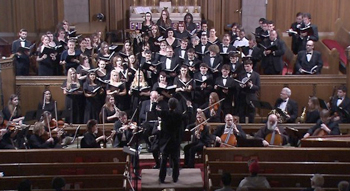by Robert Rollin

Bach’s contribution was to greatly shorten and rearrange the piece by giving Homilius a list of order and key changes, moving some of the vocal parts to different ranges and eliminating the boy soprano part. It was first performed for Easter, 1775, but the manuscript was forgotten for about two hundred years thereafter.
Prior to the performance Youngstown State University Professor Randall Goldberg, who had partnered in editing the new full score with his former professor, David Melamed of Indiana University, presented a pre-concert talk about the piece.
After briefly tracing oratorio history back to both Italian and German roots, Goldberg outlined its narrative nature. Though never staged, the oratorio (or historia, in German) approximated drama by having an evangelist relate the story in recitative, and such people as Jesus, Peter, Pontius Pilate, and even common folk, soloists, choruses, and the congregation musically participated or reacted, very briefly or at length, to the action.
During World War II the Nazis moved the Luke Passion manuscript with many other works to Krakow, Poland. When the Russians invaded they moved it further east to Kiev, Ukraine. After the war the piece was ultimately returned to Germany.
Monday’s performance, sung in German, was a well-prepared collaboration of the Dana Chorale (turba or crowd chorus), the YSU Chorus, the Trinity United Methodist Church Choir, an orchestra of students, faculty and guest artists, and professional and student vocal soloists conducted by Hae-Jong Lee.
The piece is a mélange of narrative recitative accompanied by harpsichord and continuo, orchestrally accompanied recitatives, choruses, arias, several soloist ensemble groupings, and congregational chorales. The musical diversity, combined with great variance in movement lengths, made for a lively evening.
Tenor Cory Shotwell sang the Evangelist role with real skill. Given that he was situated stage left and the harpsichord oddly on the extreme stage right, the ensemble in continuo sections was generally good.
Bass Jason Budd was exemplary as Jesus. Budd’s marvelous dark vocal color has gained him international success, particularly in buffa roles. He was especially outstanding in No. 11, the aria, Now Disciple, I Go to My Father’s Kingdom, negotiating the complex chromaticism with great expression. Bass Max Pivik had fine vocal color as Pontius Pilate in No. 12g and joined Shotwell and Budd for an expressive recitative.
Soprano Elena Mullins sang a bit too softly and unevenly in No. 5, Hell is Gearing Up for War, her first aria, but was consistently fine in subsequent solos and recitatives. She was particularly effective in No. 17, Surrounded by a Pack of Sinners, a long and complex da capo aria with considerable chromaticism. She also excelled in No. 19, the trio, In Quiet Tears I Wish to Weep, joining Shotwell and soprano Rebecca Enlow for a beautiful performance.
Alto Rachel Pavloski performed nobly in No. 7, I Lift Up My Eyes Oh God and in the subsequent accompanied recitative. Her vocal quality was wonderful, though she sometimes struggled to be heard over the accompaniment.
The choruses were consistently excellent. No 23, When Finally I Shall Enter into Your Kingdom; No. 25b, We Were Going Like Wandering Sheep; and No 26, Have Mercy, You Man of Sorrows, all displayed fine skill.
The Johann Sebastian Bach organ pieces used as prelude and postlude to the performance were nicely played by organists Sean Baran and Adam Zagotti. The evening constituted the modern premiere of the St. Luke Passion and more than justified the struggles of preparation.
Published on ClevelandClassical.com April 3, 2014
Click here for a printable version of this article.



